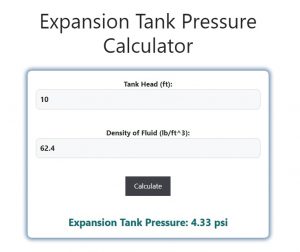About Expansion Tank Pressure Calculator (Formula)
An expansion tank is a vital component in various fluid systems, particularly in heating and cooling applications. It serves to accommodate the thermal expansion of liquids and helps maintain pressure within the system. Understanding the pressure within an expansion tank is crucial for its effective operation. The Expansion Tank Pressure Calculator simplifies this process by allowing users to quickly calculate the required pressure based on specific parameters such as tank head and fluid density. This ensures that systems operate efficiently and safely.
Formula
The formula to calculate the pressure in an expansion tank is:
Expansion Tank Pressure = (Tank Head * Fluid Density) / 144
Where:
- Tank Head: The height of the fluid column in the tank, usually measured in feet.
- Fluid Density: The mass per unit volume of the fluid, typically measured in pounds per cubic foot (lb/ft³).
How to Use
To use the Expansion Tank Pressure Calculator effectively, follow these steps:
- Gather Required Data: Collect the necessary information, including the tank head (in feet) and the fluid density (in lb/ft³).
- Input the Values: Enter these values into the calculator.
- Calculate Pressure: The calculator will apply the formula and return the expansion tank pressure.
- Analyze Results: Use the calculated pressure to ensure the expansion tank operates within the optimal pressure range for your system.
Example
Let’s consider an example where you need to calculate the expansion tank pressure for a system with the following parameters:
- Tank Head: 10 feet
- Fluid Density: 62.4 lb/ft³ (for water)
Using the formula:
- Calculate Pressure:
- Expansion Tank Pressure = (10 * 62.4) / 144
- Expansion Tank Pressure = 624 / 144
- Expansion Tank Pressure ≈ 4.33 psi
In this example, the pressure in the expansion tank would be approximately 4.33 psi.

FAQs
- What is an expansion tank?
- An expansion tank is a device used to absorb excess pressure and accommodate the expansion of liquids in heating and cooling systems.
- Why is it important to calculate expansion tank pressure?
- Correct pressure ensures the efficient operation of the system, preventing damage due to overpressure or underpressure conditions.
- What units are used for tank head?
- Tank head is typically measured in feet.
- How is fluid density measured?
- Fluid density is usually expressed in pounds per cubic foot (lb/ft³).
- What happens if the expansion tank pressure is too high?
- Excessive pressure can lead to system failures, leaks, or even explosions in extreme cases.
- What are common fluids used in expansion tanks?
- Water, glycol, and other heat transfer fluids are commonly used in expansion tanks.
- Can the Expansion Tank Pressure Calculator be used for other fluids?
- Yes, as long as you know the density of the fluid, you can use the calculator for various liquids.
- How often should I check my expansion tank pressure?
- It is recommended to check the pressure regularly, especially before seasonal changes in heating or cooling systems.
- What is the significance of the 144 in the formula?
- The number 144 converts the pressure calculation from pounds per square foot (lb/ft²) to pounds per square inch (psi).
- How does temperature affect fluid density?
- Temperature changes can affect fluid density; for accurate calculations, ensure the density is based on the operating temperature of the fluid.
- What should I do if the expansion tank pressure is too low?
- If the pressure is too low, you may need to adjust the system or refill the expansion tank to the appropriate level.
- Can expansion tanks be installed vertically?
- Yes, expansion tanks can be installed in various orientations, but horizontal installation is more common.
- Do all heating systems require expansion tanks?
- Most closed-loop heating systems require expansion tanks to manage pressure changes.
- How does an expansion tank prevent water hammer?
- By absorbing shock waves caused by sudden changes in water flow, an expansion tank helps prevent water hammer in pipes.
- What maintenance is required for expansion tanks?
- Regular inspection for leaks, checking pressure, and ensuring proper operation are crucial maintenance steps.
- Can I calculate expansion tank pressure for HVAC systems?
- Yes, the calculator is applicable for HVAC systems that use expansion tanks to manage pressure.
- How do I know if my expansion tank is functioning properly?
- A properly functioning expansion tank maintains consistent pressure; unusual fluctuations may indicate a problem.
- What are the signs of a failing expansion tank?
- Signs include water leaks, unusual pressure readings, and noises from the tank.
- Is there a maximum pressure limit for expansion tanks?
- Yes, each expansion tank has a specified maximum pressure limit, which should never be exceeded.
- Can expansion tanks be repaired?
- In some cases, expansion tanks can be repaired; however, replacement may be necessary for severe damage.
Conclusion
The Expansion Tank Pressure Calculator is an essential tool for engineers and technicians involved in fluid systems. By accurately calculating the pressure within expansion tanks, users can ensure the optimal performance and longevity of their systems. Regular pressure assessments and proper maintenance contribute to safe and efficient operations in various applications, from residential heating systems to industrial processes. Understanding how to use this calculator and the underlying principles of expansion tanks can significantly enhance system reliability and safety.
